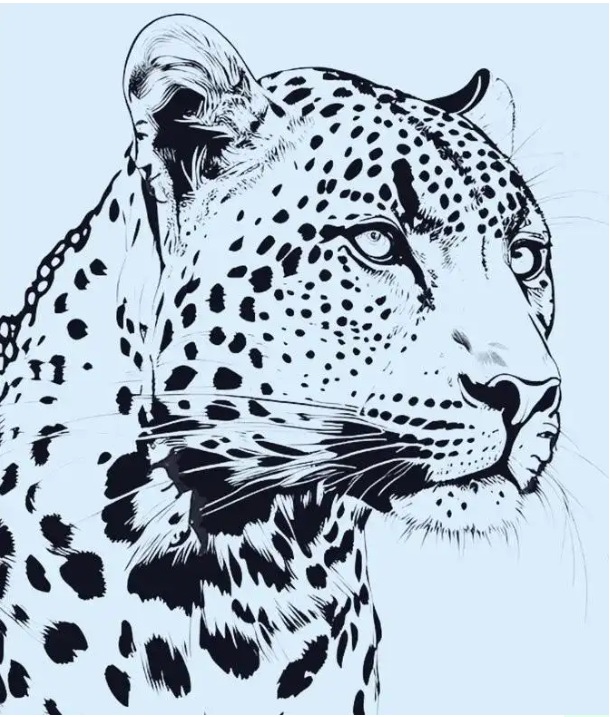Leopard Majesty: Unveiling the Secrets of the Spotted Predator
The Allure of the Leopard’s Gaze
Have you ever locked eyes with a leopard portrait and felt a jolt of wild energy surge through you? That arresting side profile—whiskers poised, eyes alert, and that iconic spotted coat—captures everything we adore about these big cats: grace, power, and an enigmatic calm that hints at hidden ferocity. In this article, we’ll dive into the world of leopards, exploring their behavior, habitat, conservation status, and tips for photographing these elusive masters of stealth.

Origins and Distribution: Where Leopards Roam
Leopards (Panthera pardus) boast one of the largest geographic ranges of any big cat, from the savannas of sub-Saharan Africa to the jungles of Southeast Asia. They’ve adapted to diverse environments—rocky mountains, dense rainforests, and even arid deserts. Isn’t it remarkable that the same species can thrive both in the African Serengeti and the Indian subcontinent’s tiger territory? Their secret lies in adaptability: leopards flex their diet, adjust their activity patterns, and even change their coat density to suit local climates.
Spot Patterns and Camouflage: Nature’s Masterpiece
Take a closer look at that stunning coat in our photo: each rosette and spot serves more than cosmetic appeal. Leopards use these markings as living camouflage, breaking up their silhouette against dappled light. It’s like wearing a bespoke suit that shifts with every shadow and sunbeam. Hunters and photographers alike marvel at how a leopard can slip within yards of prey—or your camera lens—without detection.
Behavioral Insights: Solitary Shadows of the Night
Unlike lions that thrive in prides, leopards are consummate loners. They patrol territories that can span up to 50 square miles, marking trees with claw scars and scent sprays to warn rivals. You might catch them lounging on a high branch by day, snoozing like an oversized house cat. But after sunset, they spring into action: stalking, pouncing, and hauling hefty carcasses up into canopy forks to keep scavengers at bay. Have you ever wondered how a single leopard can haul a kudu twice its weight into a tree? That raw strength ignites our fascination.

Hunting Tactics: The Art of the Ambush
Leopards are ambush specialists. They’ll crouch for minutes, muscles coiled, eyes locked on unsuspecting impalas or warthogs. When the moment arrives, they explode forward in a blur, reaching speeds of up to 36 miles per hour. This brutal ballet—patience, precision, power—underscores why leopards succeed where many predators fail. They don’t rely on long chases; they rely on surprise. Kind of like a ninja with paws instead of shuriken.
Conservation Challenges: Threats on the Rise
Despite their adaptability, leopards face mounting pressures. Habitat loss from agriculture, human–wildlife conflict, and poaching for skins and traditional medicine push populations into fragmented pockets. In some regions, leopards come into contact with livestock, leading to retaliatory killings. Picture a world map dotted with shrinking “leopard islands”—that’s where conservationists are racing against the clock to maintain genetic diversity and safe corridors.

Success Stories: Conservation in Action
Thankfully, not all news is grim. Community-led reserves in South Africa have turned former cattle ranges into leopard sanctuaries, using livestock-guarding dogs to reduce predation and bolster coexistence. In India’s Jim Corbett National Park, anti-poaching patrols and robust legal protections have stabilized local leopard populations. When schools educate kids about the ecological role of big cats, attitudes shift from fear to pride. What if every town near leopard habitat adopted similar community engagement? That ripple effect could safeguard thousands of lives—both human and feline.
Wildlife Photography Tips: Capturing the Elusive
That crisp leopard portrait you’re admiring didn’t happen by accident. Here’s how you can get closer to feline magic without disturbing the animal:
- Choose the Right Lens: A 200–400mm telephoto keeps you at a safe distance yet fills the frame.
- Patience Pays Off: Leopards are masters of concealment. Spend hours near waterholes at dawn and dusk when they’re most active.
- Mind the Light: Soft morning glow and late-afternoon warmth accentuate spots and contours. Avoid harsh midday sun, which flattens details.
- Blend In: Wear muted earth tones and keep movements slow. Even a twig snap can send a leopard slinking away.
- Respect Boundaries: Never bait or stress wildlife for a shot. Ethical photography ensures these predators remain wild and untraumatized.

Leopard Symbolism: From Myth to Modern Culture
Across cultures, leopards symbolize grace, strength, and cunning. In African folklore, they often represent kingship and stealth. Ancient Assyrians adorned thrones with leopard pelts to signal power. Today, luxury brands use leopard motifs to convey elegance and exotic flair. When you wear leopard print, you tap into millennia of cultural resonance—transforming everyday style into a tribute to this majestic creature.
Leopard vs. Other Big Cats: A Quick Comparison
- Lion: Social and vocal, lions hunt in prides; leopards operate solo and pounce silently.
- Tiger: Tigers rely on brute force in dense forests; leopards combine stealth and agility.
- Jaguar: Jaguars inhabit the Americas and boast the strongest bite relative to size; leopards excel in climbing and adaptable diets.
Each big cat evolved unique strengths. Leopards stand out for their tree-climbing feats: turning treetops into private dining rooms far above jealous hyenas.
Protecting Future Generations: How You Can Help
Even if you never set foot in the wild, your choices matter:
- Support Ethical Ecotourism: Visit parks and operators that reinvest in local communities and conservation.
- Adopt a Wild Cat: Symbolic adoptions through reputable charities fund anti-poaching patrols and research.
- Spread Awareness: Share stunning leopard images and facts on social media to spark curiosity and care.
- Reduce Demand for Illegal Wildlife Products: Say no to souvenirs or medicines that exploit big cats.
Small steps by millions of people can tilt the balance toward coexistence.
The Leopard’s Legacy: A Call to Action
The leopard in our striking photo embodies centuries of wild elegance and evolutionary brilliance. Yet its fate hangs in the balance, swayed by habitat encroachment and human conflict. By celebrating this big cat’s beauty—through photography, storytelling, and conservation advocacy—we amplify the roar for action. Will you answer the call? Together, let’s ensure that future generations inherit a world where leopards continue to roam free, shadows flickering through moonlit grasslands, reminders of nature’s raw magic.

Conclusion: Embracing the Spotted Enigma
From the sun-dappled savannahs of Africa to the misty foothills of Asia, leopards thrive on stealth, strength, and serene focus. Their spotted coats weave seamlessly into forests and grasslands, a testament to millions of years of adaptation. Yet modern pressures threaten their reign. By deepening our understanding of leopard behavior, supporting ethical wildlife photography, and engaging in grassroots conservation, we can help preserve the majesty captured in that unforgettable portrait. So next time you gaze upon a leopard’s profile, remember: you’re witnessing evolution’s masterpiece—and you hold the power to safeguard its future.




